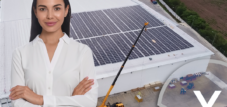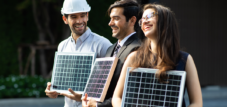Substructure & Installation – Solar systems without clamps: The ingenious trick for faster and more cost-effective installation
Language selection 📢
Published on: August 19, 2025 / Updated on: August 19, 2025 – Author: Konrad Wolfenstein

Substructure & Installation – Solar systems without clamps: The ingenious trick for faster and more cost-effective installation – Image: Xpert.Digital
NEW: Solar systems without clamps: The ingenious trick for faster and more cost-effective installation
### The special feature of module mounting without clamps, but via rail ### Fewer parts, more stability: Why this new fastening is the future of photovoltaics ### Clicking instead of screwing: You need to know about this revolution in solar systems ### Your solar system in record time? A simple rail makes all the difference ### The end of the module clamp: How a click system is turning the solar world upside down ###
Forget everything you knew about solar mounting: The rail system is coming
The solar energy boom continues unabated. More and more roofs and open spaces are being equipped with photovoltaic modules to generate clean electricity. While solar cell technology itself is making rapid advances, one crucial factor often remains hidden, yet significantly influences the costs, time, and stability of a system: installation. For years, one standard has dominated this process: attaching the modules with countless end and center clamps that require laborious screwing and adjustment. But what if this time-consuming and error-prone process were a thing of the past?
A new generation of mounting systems completely dispenses with these clamps and instead relies on a simple yet ingenious rail and click system. Instead of laboriously fixing the modules, they are simply clicked into a specially shaped rail. What at first glance may sound like a technical detail for experts reveals itself upon closer inspection as a true paradigm shift with far-reaching consequences for installers, operators, and homeowners.
In this article, we delve deep into the world of clampless module mounting. We not only explain how the innovative click-in principle works, but also highlight the tangible benefits this method brings: from drastically reduced installation time and lower labor costs to superior mechanical stability and flawless, homogenous aesthetics, as well as simplified construction site logistics. Prepare to reassess the way we think about solar installation.
Why a new fastening method?
Why is it even relevant that photovoltaic modules are not clicked in with clamps, but rather via a rail construction?
This question is crucial, as the market for photovoltaic mounting systems has grown significantly in recent years, and various systems have become established. Traditionally, solar modules are attached using so-called module end and center clamps. These are slid onto rails and secured with screws or special mechanisms. However, the approach described here completely dispenses with these clamps. Instead, the modules are inserted directly into a rail using a click system, making installation simpler, faster, and more efficient. This change may seem like a small detail at first glance, but it has significant consequences for the entire installation, for the stability and also for the aesthetics of the system.
Advice – planning – implementation
I would be happy to serve as your personal advisor.
contact me under Wolfenstein ∂ Xpert.digital
call me under +49 89 674 804 (Munich)
Installation time drastically reduced: A new click system makes it possible
The video serves as a visual demonstration of the design and functionality of the "ModuRack" mounting system for ground-mounted solar systems. A detailed 3D animation shows the step-by-step assembly of the substructure, from the foundation pillars and horizontal purlins to the fastening of the vertical support rails. The central and most innovative feature highlighted is the fastening system for the solar modules themselves: Instead of traditional clamps screwed from above, the modules are inserted into the V-shaped rails and held in place by special clips that snap into place from below. This mechanism indicates a significantly accelerated and simplified installation. The animation also illustrates the scalability of the system through the rapid assembly of a large area and finally shows the wind bracing used for bracing, which ensures the static stability of the entire system.
Solar module assembly revolution: How click-in systems are changing the photovoltaics industry
Historical development of module fastening
How have mounting systems in photovoltaics developed so far?
Originally, solar modules were screwed onto relatively simple steel or aluminum profiles. The connection was robust but time-consuming. Later, standardized clamp solutions emerged, ensuring both mechanical stability and electrical conductivity. The disadvantage, however, was the high assembly effort and the large number of small parts that were prone to errors or oversight. With the increasing demand for large-scale systems and more efficient construction methods, the need arose for a method that reduced material and labor costs. The click-in system presented here is a response to this development.
Basic principle of click-in assembly
How exactly does clicking in the modules work?
Instead of holding the modules with separate clamps, the purlins – the crossbeams of the frame – have a special rail profile. The module frames are designed so that their inner groove fits precisely into the bent edge of this rail. During installation, a module is lifted slightly and placed on the rail at an angle of approximately 15 to 25 degrees. It is then lowered and automatically engages the rail. This mechanically secures it without the need for additional clamps. After alignment, the rail is secured with a T-bolt to finally secure its position.
Advantages for assembly speed
What are the advantages of this method in terms of assembly time?
One of the biggest advantages is the significantly reduced installation time. There's no need to screw and align clamps, nor is there constant readjustment if clamps slip or are incorrectly positioned. Instead, all you need to do is insert the module, tilt it, and snap it into place. In practice, this can reduce assembly time per module by several minutes. For large systems with hundreds or even thousands of modules, this adds up to enormous time savings. Installers also report significantly easier handling because fewer tools are required and the work steps are more clearly structured.
Effects on mechanical stability
Is a clicked-in module as stable as one attached with clamps?
Yes, the stability is equivalent or even better. The rail grips the entire length of the module frame, so forces are evenly distributed. With clamps, the load is concentrated only on individual points, which can lead to greater stress on these areas during high wind or snow loads. The continuous linear support on the rail improves stability, ensuring the modules rest securely and over a large area. The risk of slipping is also eliminated, as the rail secures the module laterally and vertically.
Aesthetic advantages of rail mounting
Does appearance also play a role?
Yes, definitely. With clamp systems, the fastening points are visible at the edges, which is often perceived as distracting in roof-mounted systems. With the click-in system, these visible clamps are eliminated. The modules are aligned flush with one another, without any visible gaps caused by fastening components. This results in a very clear, homogenous module surface that is more architecturally appealing. This system offers a clear advantage, especially for projects where appearance is an important factor, such as carports, facade systems, or prestigious corporate buildings.
Electrical safety and grounding
How is electrical safety ensured if there are no terminals?
In traditional clamp systems, the clamps often also serve as electrical grounding. In the click-in system, this is achieved through special conductive clips that are inserted between the module frame and the rail. These clips penetrate the anodized aluminum frame, creating a permanent, low-resistance connection. This ensures electrical safety and standard-compliant grounding. These clips are installed in parallel with the module click-in process and are also quick and easy.
Comparison with traditional clamping systems
What is the main difference between the click-in system and traditional mounting systems?
The biggest difference lies in the simplicity. Where previously multiple components – clamps, screws, washers – would be required, here there is only the rail with its integrated functions. This significantly reduces the number of individual parts. Furthermore, the risk of small parts being lost or incorrectly inserted is eliminated. Furthermore, the large-surface support ensures more even loading and fewer localized stresses. While clamps can damage modules if tightened incorrectly, this is virtually impossible with the click-in system.
Advice – planning – implementation
I would be happy to serve as your personal advisor.
contact me under Wolfenstein ∂ Xpert.digital
call me under +49 89 674 804 (Munich)
70% fewer parts | No more clamps and screws: This ingenious invention revolutionizes the construction of solar parks
The video presents the innovative "Magic Solar System" from ModuRack, a groundbreaking mounting solution for large-scale solar systems. Using a 1-megawatt reference project, the "SPIC Daqing PV & ESS Demonstration Hub," the system's core innovation is impressively demonstrated: a unique, factory-prepared rail construction that enables secure attachment of the solar modules without the use of conventional clamps, screws, or clips. This "Lego-like" installation method leads to a drastic reduction in the number of required individual parts by 70% and significantly accelerates the installation process, resulting in lower labor costs, shorter project times, and thus a higher return on investment (ROI). To underpin the credibility and quality of the technology, the video highlights the collaboration with global industry leaders – including SPIC as investor, Jinko Solar as module supplier, and Jiangsu Guoqiang as substructure manufacturer. This positions ModuRack as a provider of a field-tested, highly efficient and future-oriented solution that is ready for the greatest challenges in the solar market.
Solar technology of the future: How a simple click drastically reduces costs and complexity
Economic consideration
Does the method also have economic advantages?
Yes, in several ways. Firstly, material costs are reduced because fewer individual parts are required. Secondly, labor costs are lower due to the shorter assembly time. This makes a significant difference, especially for large ground-mounted systems with many thousands of modules. Logistics are also simpler because fewer small parts need to be stored, transported, and distributed on the construction site. These factors combined lead to a significant cost reduction over the entire project.
Simplification of assembly
What role does this system play in the context of future PV developments?
With increasing industrialization and mass production of photovoltaic systems, simplifying installation is becoming increasingly important. Systems that require fewer steps and enable standardized processes are preferred. The click-in system fits perfectly into this development. It is conceivable that it will become the standard in the coming years and largely replace clamping systems. At the same time, new materials and automated assembly processes are being tested that could further enhance this principle.
Your partner for business development in the field of photovoltaics and construction
From industrial roof PV to solar parks to larger solar parking spaces
☑️ Our business language is English or German
☑️ NEW: Correspondence in your national language!
I would be happy to serve you and my team as a personal advisor.
You can contact me by filling out the contact form or simply call me on +49 89 89 674 804 (Munich) . My email address is: wolfenstein ∂ xpert.digital
I'm looking forward to our joint project.





















